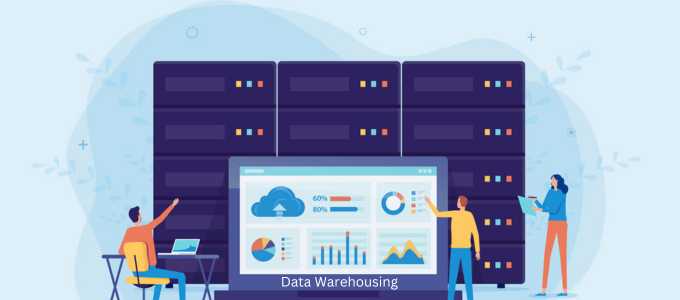The next generation of financial technology (Fintech) is not far off. Looking towards the future, we examine the arising patterns in data warehousing that are ready to shape the direction of Fintech. From the alignment of machine learning and AI to progressions in data security and protection, understanding these patterns becomes fundamental for Fintech pioneers.
This blog post foretells a future in which data warehousing in Fintech will be characterized by the integration of cutting-edge technologies, increased focus on data security and privacy, and a collaborative approach within the industry as well as the wider technological landscape. Understanding and adjusting to these arising patterns is considered urgent for stakeholders and partners in the Fintech area.
In the quickly advancing scene of Fintech, the job of data has become more essential than ever. As fintech companies continue to transform their businesses, the focus is on data warehousing and its groundbreaking impact on the new and upcoming era of financial administration. Let’s dive into the critical parts of how data warehousing is forming the eventual fate of Fintech through cutting-edge data design.
How to Keep Your Business Finances Safe and Well-Organized? – Take The Help of Data Warehousing
For companies to manage financial data effectively, it is essential to have an effective strategy that considers security, compliance, and operational effectiveness. Below are guidelines for secure financial data management:
Data Encryption
- In Transit and At Rest: Carry out encryption for financial data both during transmission (in transit) and then put away (at rest) to stop unauthorized access.
Access Controls
- Role-Based Access: Use role-based access controls to guarantee that only authorized personnel can access sensitive financial data.
- Restricted Data Diet: Limit admittance to financial data on a restricted need-to-know basis, confining it to representatives fundamental for their jobs.
Data Arrangement
- Sensitive Data Handling: Distinguish and arrange delicate financial data to focus on safety efforts.
- Information Taking Care of Rules: Based on the classification of the various types of financial data, establish clear guidelines for their handling.
Regular Audits and Surveillance
- Audit Trails: Carry out review trails and checking instruments to follow access, changes, and framework movement connected with financial data.
- Customary Reviews: Examine security holes and potential flaws regularly through internal and external audits.
Data Recovery and Backup
- Regular Backups: Lay out a normal backup schedule to guarantee that data is consistently supported.
- Recovery Plans: In the event of data loss or system failure, data recovery plans should be developed and regularly tested.
Secure Capacity
- Data Warehousing: Consider utilizing committed information warehousing arrangements with vigorous security highlights for putting away financial data safely.
- Cloud Security: Choose legitimate suppliers with strong safety efforts and consistent certificates when utilizing distributed storage.
Employee Training
- Security Training: Employees should receive extensive training on data security policies, best practices, and the significance of protecting financial data.
- Spoof Detection: Include instructions on how to detect and avoid phishing attacks, a common way to gain unauthorized access.
Compliance with the Law
- Remain Informed: Ensure that you are up-to-date with financial guidelines and industry-specific consistency requirements.
- Adherence: Guarantee that the information the executives rehearse lines up with lawful and industry guidelines, like GDPR, HIPAA, or explicit financial guidelines.
Data Quality and Exactness
- Approval Cycles: Carry out data approval cycles to guarantee the precision and trustworthiness of financial data.
- Regular Checkups: Direct intermittent reviews of financial data to distinguish and correct any errors.
Incident Response Plan
- Plan Advancement: Make an episode reaction plan illustrating moves toward be taken if there should be an occurrence of a security break or unapproved access.
- Employee Training: Train workers on the best way to follow the episode reaction plan.
Vendor security Evaluation
- Third-Party Vendors: Perform security assessments to ensure that external vendors for financial data services adhere to strict security standards.
- Contractual Arrangements: Characterize security assumptions and prerequisites in authoritative concurrences with vendors.
How Data Warehousing Works?
Unified Data Administration
In the mind-boggling scene of Fintech, where data comes from different sources like exchanges, client communications, and market patterns, it is crucial to achieve solidarity in data. Let’s explore how the centrality of data warehousing serves as a unified platform for effectively managing this array of financial data sources.
- By concentrating and coordinating data, Fintech firms can separate storehouses, smooth out cycles, and gain a complete perspective on their tasks.
- The investigation envelops the job of data warehousing in encouraging data consistency, respectability, and availability, establishing the groundwork for a more educated direction.
Examination and Experiences
Beyond just storing data, data warehousing is also a catalyst for powerful analytics that drive strategic Fintech decision-making. Let’s explore how Fintech influences progressed examination capacities inside data warehousing frameworks.
- From prescient demonstrating to drift investigation, data warehousing enables Fintech experts with the apparatuses to extract significant experiences from huge datasets.
- By outfitting this examination, Fintech firms can reveal designs, recognize amazing open doors, and alleviate gambles successfully.
- The attention here is on the extraordinary effect of data warehousing in changing crude data into noteworthy knowledge, at last forming the essential heading of financial administrations.
Important Trends Shaping the Future of Data Warehousing in Fintech
Integration of AI and ML
Extensions of coordination and machine learning (ML) are common in data warehousing frameworks. It can improve prescient examination, mechanize dynamic cycles, and give additional savvy experiences from financial data.
Advanced Analytics and Predictive Modeling
The improvement and expansion of analytics capabilities within Data Warehousing Solutions may be the focus of future trends. This incorporates more refined prescient demonstrating methods to predict market patterns, client conduct, and possible dangers.
Enhanced Data Security Efforts
As the significance of data security develops, future patterns might include the turn of events and execution of further developed and hearty safety efforts inside information warehousing frameworks to safeguard delicate financial data.
Integration of Blockchain
The investigation of incorporating blockchain innovation with information warehousing is an expected pattern. Blockchain can improve the straightforwardness, security, and detectability of financial exchanges, which aligns with the trust and security requests of the financial area.
Greater Focus on Data Security
Given expanding worries around data security, future patterns might include uplifted measures and structures inside data warehousing frameworks to guarantee consistency with worldwide information assurance guidelines and to safeguard clients’ protection.
Cloud-Based Solutions
The reception and headway of cloud-based information warehousing arrangements are probable. Cloud platforms are attractive to fintech companies because they are flexible, cost-effective, and scalable.
Collaboration Platforms
Expanded joint effort and interoperability between various Fintech stages may be a pattern. This could include the creation of standardized information trading conventions and joint efforts to work on common expertise of the fintech ecosystem.
Conclusion
In this complete aid, we investigate the extraordinary job of data warehousing in molding the eventual fate of financial innovation (Fintech). The excursion commences with a review of how Fintech has become indissoluble from data-driven independent direction and advancement. We dig into the difficulties faced by conventional financial establishments, featuring the impetus for embracing progressed data answers to stay serious in the unique financial scene.
The basis of cutting-edge data design is then fleshed out, underscoring the essential elements of versatility and consistent handling. We envision a planning framework that can flawlessly deal with massive and evolving datasets while simultaneously handling data consistently to meet the powerful needs of financial administration.
In the future, the article examines the appropriate use of Data Warehousing in Fintech. Bound together data The executives are investigated as a way to effectively oversee different financial data sources on a brought-together stage, separating storehouses and encouraging a complete perspective on tasks. Then, the focus shifts to the transformative power of data warehousing in analytics and insights, showing how fintech can use these capabilities to make more strategic and informed decisions.
Overall, this article serves as a comprehensive guide for industry experts, innovation enthusiasts, and partners eager for the future of data warehousing integration and financial innovation. By disentangling the intricacies and possibilities, it reveals insight into how data-driven systems and cooperative endeavors will make ready for the following flood of financial advancement.







